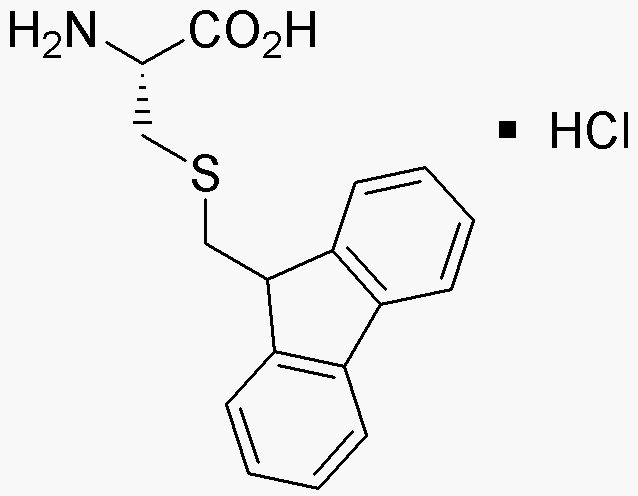S-9-Fluorenylmethyl-L-cysteine hydrochloride is widely utilized in research focused on:
- Peptide Synthesis: This compound serves as a protecting group in peptide synthesis, allowing chemists to selectively modify amino acids without affecting the overall structure. It enhances the efficiency of creating complex peptides used in pharmaceuticals.
- Drug Development: Researchers leverage its properties to develop new drugs, particularly in the field of cancer research, where it aids in the design of molecules that can target specific pathways in tumor cells.
- Bioconjugation: The compound is effective in bioconjugation processes, where it helps link biomolecules to therapeutic agents, improving the delivery and efficacy of treatments in areas like immunotherapy.
- Analytical Chemistry: It is used as a standard in analytical methods, providing a reliable reference for quantifying other compounds in complex mixtures, which is crucial for quality control in pharmaceuticals.
- Research in Protein Engineering: This chemical plays a role in modifying proteins to study their functions and interactions, aiding advancements in biotechnology and synthetic biology.
General Information
Properties
Safety and Regulations
Applications
S-9-Fluorenylmethyl-L-cysteine hydrochloride is widely utilized in research focused on:
- Peptide Synthesis: This compound serves as a protecting group in peptide synthesis, allowing chemists to selectively modify amino acids without affecting the overall structure. It enhances the efficiency of creating complex peptides used in pharmaceuticals.
- Drug Development: Researchers leverage its properties to develop new drugs, particularly in the field of cancer research, where it aids in the design of molecules that can target specific pathways in tumor cells.
- Bioconjugation: The compound is effective in bioconjugation processes, where it helps link biomolecules to therapeutic agents, improving the delivery and efficacy of treatments in areas like immunotherapy.
- Analytical Chemistry: It is used as a standard in analytical methods, providing a reliable reference for quantifying other compounds in complex mixtures, which is crucial for quality control in pharmaceuticals.
- Research in Protein Engineering: This chemical plays a role in modifying proteins to study their functions and interactions, aiding advancements in biotechnology and synthetic biology.
Documents
Safety Data Sheets (SDS)
The SDS provides comprehensive safety information on handling, storage, and disposal of the product.
Product Specification (PS)
The PS provides a comprehensive breakdown of the product’s properties, including chemical composition, physical state, purity, and storage requirements. It also details acceptable quality ranges and the product's intended applications.
Certificates of Analysis (COA)
Search for Certificates of Analysis (COA) by entering the products Lot Number. Lot and Batch Numbers can be found on a product’s label following the words ‘Lot’ or ‘Batch’.
*Catalog Number
*Lot Number
Certificates Of Origin (COO)
This COO confirms the country where the product was manufactured, and also details the materials and components used in it and whether it is derived from natural, synthetic, or other specific sources. This certificate may be required for customs, trade, and regulatory compliance.
*Catalog Number
*Lot Number
Safety Data Sheets (SDS)
The SDS provides comprehensive safety information on handling, storage, and disposal of the product.
DownloadProduct Specification (PS)
The PS provides a comprehensive breakdown of the product’s properties, including chemical composition, physical state, purity, and storage requirements. It also details acceptable quality ranges and the product's intended applications.
DownloadCertificates of Analysis (COA)
Search for Certificates of Analysis (COA) by entering the products Lot Number. Lot and Batch Numbers can be found on a product’s label following the words ‘Lot’ or ‘Batch’.
*Catalog Number
*Lot Number
Certificates Of Origin (COO)
This COO confirms the country where the product was manufactured, and also details the materials and components used in it and whether it is derived from natural, synthetic, or other specific sources. This certificate may be required for customs, trade, and regulatory compliance.


